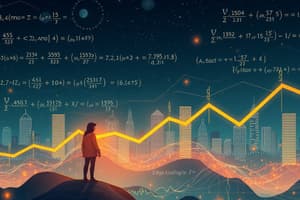Podcast
Questions and Answers
What is the main concept explored in the field of macroeconomics?
What is the main concept explored in the field of macroeconomics?
- Interest rates
- GDP
- Inflation
- Unemployment (correct)
Which type of unemployment occurs due to changes in the economy's demands for skills or industries?
Which type of unemployment occurs due to changes in the economy's demands for skills or industries?
- Cyclical unemployment
- Frictional unemployment
- Structural unemployment (correct)
- Seasonal unemployment
During which economic phase does cyclical unemployment typically rise?
During which economic phase does cyclical unemployment typically rise?
- Stagnation
- Expansion
- Economic growth
- Recession (correct)
How is the unemployment rate calculated?
How is the unemployment rate calculated?
Which of the following is a brief period of unemployment that occurs during job transitions?
Which of the following is a brief period of unemployment that occurs during job transitions?
What type of data does the U.S. Bureau of Labor Statistics publish monthly related to unemployment?
What type of data does the U.S. Bureau of Labor Statistics publish monthly related to unemployment?
What is one of the negative impacts of high levels of unemployment on an economy?
What is one of the negative impacts of high levels of unemployment on an economy?
Which organization publishes the Global Employment Trends report annually?
Which organization publishes the Global Employment Trends report annually?
What is one tool that policy makers can use to address unemployment by increasing borrowing and spending?
What is one tool that policy makers can use to address unemployment by increasing borrowing and spending?
What type of policies provide incentives for businesses to hire unemployed workers?
What type of policies provide incentives for businesses to hire unemployed workers?
Why is it essential for economists to analyze the unemployment rate along with other economic indicators?
Why is it essential for economists to analyze the unemployment rate along with other economic indicators?
What action can governments take through fiscal policy to stimulate job creation?
What action can governments take through fiscal policy to stimulate job creation?
Study Notes
Exploring Macroeconomics Through the Lens of Unemployment
Macroeconomics, the study of an economy as a whole, is a critical field that sheds light on the complex behavior of large-scale economic systems. Within this expansive territory, one of the most widely discussed and monitored aspects is unemployment, which refers to the number of individuals who are actively seeking work but cannot find employment.
Unemployment Defined
Unemployment is not a single, uniform concept. Economists classify it into three main categories:
- Frictional Unemployment: Occurs as individuals transition between jobs, causing a brief period of unemployment while searching for new opportunities.
- Structural Unemployment: Results from shifts in the economy, such as changing demands for skills or the closure of specific industries, leaving workers unable to find employment in their field.
- Cyclical Unemployment: Arises during times of economic downturn, when demand for labor decreases and job losses occur.
Measuring Unemployment
Unemployment is typically measured via the unemployment rate, which is calculated by dividing the number of unemployed individuals by the total labor force and multiplying by 100. A labor force is defined as the sum of employed and unemployed workers. The U.S. Bureau of Labor Statistics (BLS) publishes monthly unemployment data for the United States, which is a vital indicator of the nation's economic health.
Unemployment and Economic Indicators
Macroeconomists view unemployment as an important factor that influences the overall health of an economy. High levels of unemployment can lead to lower consumer spending, reduced aggregate demand, and slower economic growth. Conversely, low levels of unemployment can contribute to increased demand for labor, higher wages, and a stronger economy.
The unemployment rate is often analyzed along with other economic indicators, such as inflation, economic growth, and interest rates, to form a complete picture of the economy's performance. Economists frequently use various tools and models to forecast and analyze unemployment rates to inform policy decisions and monetary actions.
Unemployment in a Global Context
Unemployment is a global issue, and the International Labor Organization (ILO) provides a comprehensive perspective on labor market trends around the world. The organization publishes the Global Employment Trends report every year, which examines labor market trends, employment projections, and unemployment patterns globally.
Unemployment and Public Policy
Policy makers and governments have various tools at their disposal to address unemployment. Some of these include:
- Monetary policy, such as lowering interest rates to increase borrowing and spending.
- Fiscal policy, such as government spending on public works projects, tax cuts, or subsidies to stimulate job creation.
- Training and education programs to improve job skills and increase employability.
- Active labor market policies, such as wage subsidies, which provide incentives for businesses to hire unemployed workers.
Conclusion
Unemployment, as a foundational aspect of macroeconomics, provides valuable insights into the behavior of large-scale economic systems. It is essential to understand the nuances of unemployment and its impact on economic growth, consumer behavior, and public policy decisions. By staying informed about unemployment trends, economic indicators, and policy decisions, we can better understand how our economy functions and how we might improve its efficiency and resilience.
Studying That Suits You
Use AI to generate personalized quizzes and flashcards to suit your learning preferences.
Description
Delve into the intricate realm of macroeconomics by examining the multifaceted concept of unemployment. Learn about different types of unemployment, how it is measured, its significance as an economic indicator, and the global perspective on unemployment trends and public policies.




